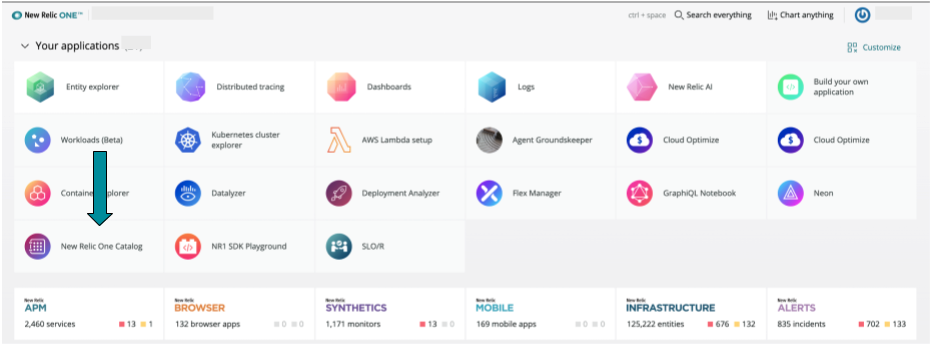At FutureStack in September 2019, we announced programmability as the ability to build custom applications on the New Relic One platform. We were excited to take that first step in the programmability journey, but we recognized there was a need to be able to configure and customize all your data—regardless of where you are in the programmability adoption journey.
You voiced that need to us and today, we’re excited to announce the General Availability (GA) of the New Relic One Catalog and the Developer Toolkit. These features will allow you to experience the power of programmability with just a few clicks.
What is the New Relic One Catalog?
The New Relic One Catalog significantly lowers the barrier of entry to adopting New Relic One applications. By providing a user experience directly in the platform, the New Relic One Catalog makes the discovery, installation, and management of 16-plus global applications seamless and intuitive—and we’re always adding more. To get started using applications (e.g., Cloud Optimize, Datalyzer), you will no longer have to download the CLI, clone a repository, and run the deploy command.

But wait, there’s more. What is the New Relic Developer Toolkit?
We are also announcing the Developer Toolkit, a collection of New Relic-supported orchestration tools, including Terraform, AWS CloudFormation, and a cross-product command-line interface. These tools enable you to integrate New Relic into your existing workflows, easing adoption, accelerating deployment, and returning focus to your core business.
We created these tools to provide developers with the ability to integrate observability into automation workflows. As a developer, you have complete control through the New Relic Client. When you deploy a service, you want to embed the New Relic configuration in code with the rest of the service definition. When you audit your systems, you want an easy way to verify the New Relic configuration is defined as expected. You might have heard of this concept, Observability as Code.
As a refresher, observability means you can answer any questions about what's happening on the inside of the system just by observing the outside of the system, without having to ship new code to answer new questions. However, with programmability, you can use code to extend the capabilities of observability. This is where the Developer Toolkit comes in handy.
The Developer Toolkit includes:
- New Relic Terraform Provider: Enables Observability as Code, reduces developer toil, and allows users to manage their entire ecosystem in a single place.
- New Relic Client: Provides the building blocks for many tools in the toolkit, enabling quick access to the suite of New Relic APIs. As a library, it can also be leveraged within your own custom applications.
- New Relic CLI: Enables integration of New Relic into your existing workflows. Be it fetching data from your laptop while troubleshooting an issue, or adding New Relic into your CI/CD pipeline.
- New Relic AWS CloudFormation Integration: Enables developers using CloudFormation to provision a subset of New Relic resources easily.
Let’s build together
We’re on the programmability journey together, and we’re always excited to see developers in the wild use our programmability features. Check out how Picnic, the fastest online supermarket in Europe, extended its capabilities for inventory management and customer experience.
We are continuously working on new projects to improve the developer experience. We truly believe in being open, connected, and programmable, which is why we’d love to engage with you.
If you have any questions or comments about any of the new product features mentioned, please reach out to our team at deco@newrelic.com or join in on the conversation with the developer community at discuss.newrelic.com.
[embed]https://www.youtube.com/watch?v=0plNgMVAqYY[/embed]
As opiniões expressas neste blog são de responsabilidade do autor e não refletem necessariamente as opiniões da New Relic. Todas as soluções oferecidas pelo autor são específicas do ambiente e não fazem parte das soluções comerciais ou do suporte oferecido pela New Relic. Junte-se a nós exclusivamente no Explorers Hub ( discuss.newrelic.com ) para perguntas e suporte relacionados a esta postagem do blog. Este blog pode conter links para conteúdo de sites de terceiros. Ao fornecer esses links, a New Relic não adota, garante, aprova ou endossa as informações, visualizações ou produtos disponíveis em tais sites.


